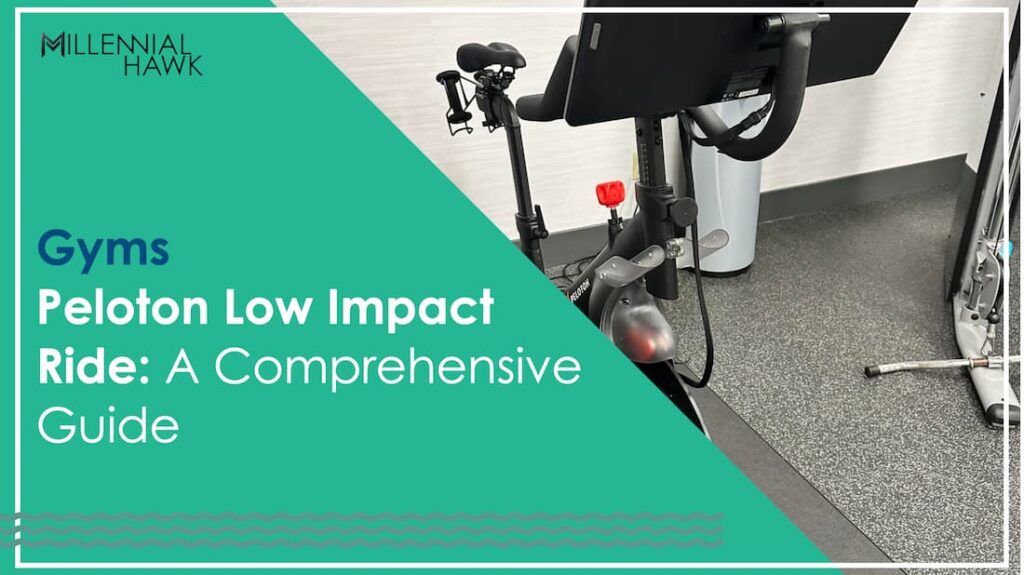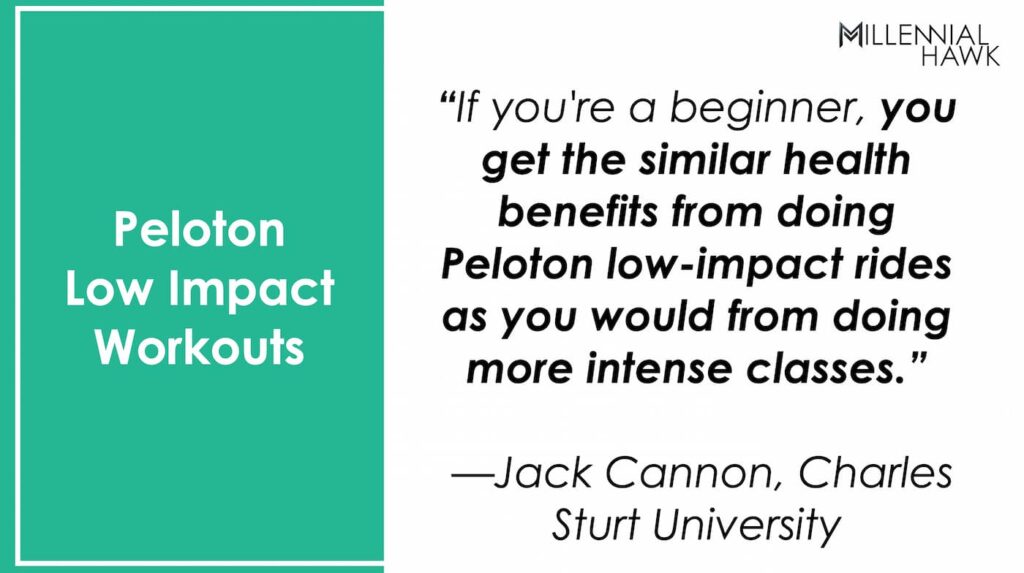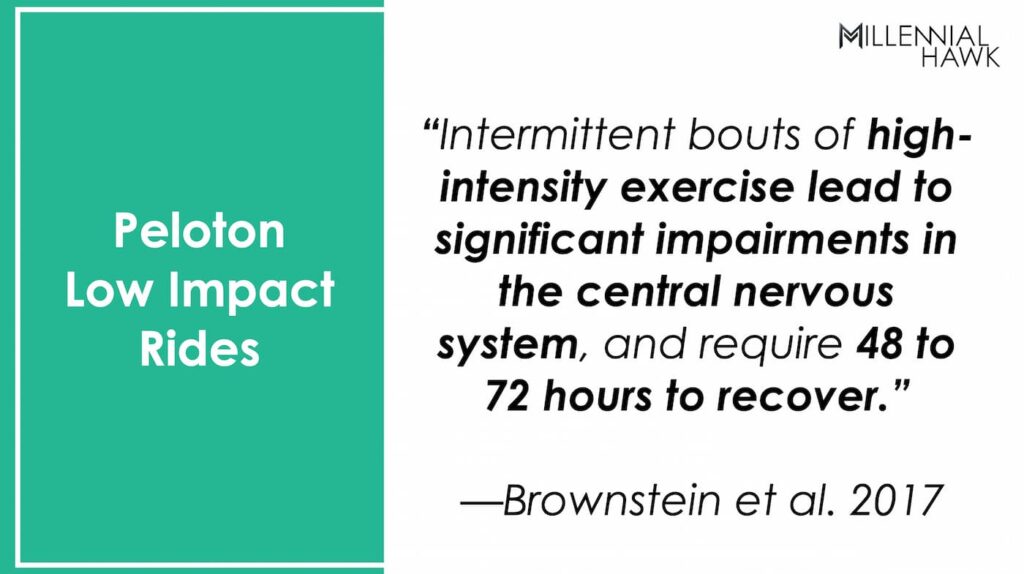
A Peloton low-impact ride refers to cycling classes primarily done while seated, with moderate intensity, at around 50 resistance and 100 cadence. While the effort of Peloton Low Impact rides varies based on your fitness level, they typically feel like you’re breathing heavily, but you can still chat comfortably. Peloton instructor Tunde Oyeneyin says, “Low impact doesn’t equate to low effort or minimal rewards.”
The best Peloton Low Impact Ride is Hannah Corbin’s 45-minute class becasue it’s a steady “All day” pace suitable for all levels and long enough to break a good sweat. The main benefit of doing Peloton Low Impact rides is that they are gentle on your joints while providing an effective workout. Research by Daniel G. Carey at the University of St. Thomas suggests that such low to medium-intensity training can help improve aerobic fitness and aid in weight control, making it a valuable addition to your Peloton wokrout plan.
Peloton Low Impact Rides aren’t the only steady-state cycling classes; Peloton Recovery Rides and Peloton Beginner Rides also emphasize staying in the saddle. However, these classes differ from the Low Impact Rides in their structure, duration, intensity, and benefits.
What is a Peloton Low Impact Ride?
The Peloton Low Impact Ride is a medium-intensity cycling workout ideal for those seeking a gentler option. These rides, which range from 10 to 45 minutes, feature diverse music playlists with RPMs (Revolutions Per Minute) of 70-100, helping you maintain a cadence under 100 and resistance below 50. Although Peloton Low Impact Ride incorporates elements of interval training, they’re not your typical HIIT cycling classes.
These rides are primarily done in the saddle, designed to keep your heart rate around 60-70% of your maximum, similar to Zone 2 training intensity, often described as an “all day” pace. Peloton defines their low-impact rides as perfect for recovery, ensuring you still enjoy a fantastic cycling workout. ‘Low-impact’ doesn’t mean low-calorie burn, easy, or for beginners. It refers to any exercise that elevates your heart rate while minimizing stress on your joints.
For me, Peloton Low Impact rides are like hidden gems, especially during my weight loss journey. Why? Well, with less strain on my joints and ‘just right’ intensity, I could hop on my bike 5-6 times a week without feeling exhausted, achy, or sore the next day. I’m not sure how many calories I’ve burned, but over the 6 months, they helped me lose over 20 lbs.
How Does The Peloton Low Impact Ride Work?
The Peloton Low Impact Ride works similarly to other cycling classes but has few key distinctions. During these rides, you’re expected to maintain an effort level of around 4-5 on the RPE scale, keeping your heart rate within the fat-burning zone. This is typically between 60.2% and 80.0% of the maximal heart rate, according to Daniel G. Carey’s 2009 study in The Journal of Strength & Conditioning Research. Your power output will generally stay within Zones 2 and 3, enabling you to sweat yet be able to maintain a conversation.
Peloton Low Impact Rides are great for beginners because they let you get in 150 to 300 minutes of moderate-intensity exercise each week, which matches the WHO recommendations. And the best part is that moderate intensity is enough to kickstart training improvements for folks who are new to exercise.
For me, Peloton Low Impact Rides are ideal because I can stack 2-3 classes back-to-back for up to a 2-hour workout, without needing recovery from it the next day. These are the types of workouts I prefer on Saturday mornings to accumulate my weekly cycling miles and stay in shape, even though I have a desk job.
How Does The Peloton Low Impact Ride Work for Beginners?
For beginners, low-impact Peloton rides can offer similar health benefits as more intense Peloton classes, but with the added advantage of being easier on the joints and reducing the likelihood of soreness post-workout.

In a study by Jack Cannon from Charles Sturt University, untrained women were divided into two groups to compare training adaptations from leg curls at 50-75% intensity. Group A did one set of 10 reps, while Group B did three sets of 10 reps, both three times per week. After 10 weeks, there was no significant difference in lean muscle mass gains between the two groups.
What are the Benefits of Peloton Low Impact Rides?
The benefits of Peloton Low Impact Rides are listed below.

- Enhances Recovery: Peloton Low-impact rides allow for more frequent workouts by preventing excessive muscle soreness, making it easier to stay consistent with your training. A study by Miller et al. in 1987 at Children’s Hospital in San Francisco showed that when you exercise intensely, your muscle strength can decrease by 90%. On the other hand, doing low-impact rides at 60-70% of your maximum heart rate doesn’t create neuromuscular fatigue and doesn’t tax the body to that extent.
- Reduces Appetite: Peloton low-impact rides offer a balanced approach to exercise without triggering excessive hunger. Studies by Doucet et al. (2018) and Rosenkilde et al. (2012) have shown that extended periods of high-intensity workouts can result in a “rebound” effect, leading to increased food consumption to compensate for intense activity. In contrast, incorporating low-intensity activities such as Peloton low-impact rides has been associated with reduced cravings and appetite.
- Increases Diversity: Peloton low-impact classes complement high-intensity and climbing classes, offering a balanced training regimen that enhances overall performance and prevents overtraining. They also provide a welcoming entry point for beginners looking to start their fitness journey without overwhelming intensity.
- Alleviates back pain: Peloton low-impact rides are beneficial for people with a bad back due to their gentle approach to exercise. A 2022 study by Natasha C Pocovi published in the Journal of Orthopaedic & Sports Physical Therapy has shown that low-impact cycling, similar to Peloton rides, is effective in reducing pain and disability in individuals with chronic or recurrent low back pain.
- Supports Weight Loss: Peloton Low-impact rides provide an effective way to burn calories without causing excessive muscle fatigue. A 2012 study by Mads Rosenkilde at the University of Copenhagen revealed that moderate exercise for 30 minutes daily led to similar weight and fat loss as 60 minutes of high-intensity exercise, despite the latter burning more calories.
In my experience, low-impact rides, such as those with Sam Yo, have been fantastic for weight loss and maintenance. Sam’s 45-minute class incorporates light arm exercises and strikes a great balance between cadence and resistance, helping boost metabolism without pushing too hard. These rides not only burn calories but also help curb my appetite, making them an essential part of my workout routine.
What are the Drawbacks of Peloton Low Impact Rides?
The following list shows the potential drawbacks of Peloton’s low-impact rides.
- Not Challenging Enough: May not sufficiently push seasoned cyclists or those in advanced training phases.
- Lower Calorie Burn: Compared to high-intensity classes, these rides burn fewer calories.
- Potential Plateauing: Regular users might hit a fitness plateau without varied intensity.
- Limited Cardiovascular Stress: Less effective for improving cardiovascular endurance.
- Minimal Muscle Building: Not optimal for those focusing on muscle strength or hypertrophy.
Who are Peloton Low Impact Rides Suitable for?
Peloton Low Impact Rides cater to all fitness levels, including beginners, intermediates, and advanced riders. They’re especially good for building aerobic capacity, aligning with Stephen Seiler’s research at the University of Agder, which highlights the importance of balancing low- and high-intensity training.
Typically, about 80% of workouts should be low intensity, maintaining blood lactate around 2 mM, with the remaining 20% focusing on high-intensity intervals at roughly 90% of VO2max. On the other hand, Peloton Low Impact rides are not ideal if you’re seeking a short-term challenge for maximum calorie burn.
When is the right time to do a low-impact Peloton ride?
The best time for a low-impact Peloton ride is when it complements your workout routine or recovery needs.
- Post-Strength or Bootcamp: Ideal after intense strength or bootcamp sessions to aid recovery.
- On Recovery Days: Perfect for active recovery on rest or weekend days.
- As Morning Cardio: Great for a gentle start to the day, promoting blood flow without overexertion.
- Returning from a Break: Suitable after a hiatus from exercise to ease back into physical activity.
- As a Warm-up/Cool-down: Useful as a warm-up before intense workouts or a cool-down after them.
What is the Wokrout Plan for Peloton Low Impact Rides?
The ideal workout schedule for the Peloton Low Impact rides varies depending on your goals, preferences, and fitness levels. This table demonstrates how you can structure your wokrout plan for Peloton Low Impact rides.
| Day | Peloton Workout | Duration | Focus |
|---|---|---|---|
| Monday | Full-body strength training | 30 minutes | Legs, arms, core |
| Tuesday | Peloton Low-Impact ride | 30 minutes | Cardiovascular fitness |
| Wednesday | Upper body strength training | 20 minutes | Arms, chest, shoulders, back |
| Thursday | Peloton Low-Impact ride | 45 minutes | Cardiovascular fitness |
| Friday | Lower body strength training | 25 minutes | Legs |
| Saturday | Active recovery or flexibility training | 30 minutes | Flexibility, balance |
| Sunday | Peloton Low-Impact ride | 45 minutes | Cardiovascular fitness |
What are the Best Peloton Low Impact Rides?
The best Peloton low-impact rides include:
- 45 min Low Impact Ride with Hannah Corbin on Thu 1/28/21.
- 45 min Low Impact Ride with Kendall Toole on Sun 5/14/23.
- 45 min Low Impact Ride with Sam Yo on Sat 5/22/21
- 45 min Low Impact Ride with Tunde Oyeneyin on Wed 3/23/22
- 45 min Low Impact Ride with Christine D’Ercole on Sun 4/25/21
- 45 min Low Impact Ride with Mayla Wedekind on Sat 12/18/21
- 30 min Low Impact Ride with Sam Yo on Sun 12/3/23
For me, the 45-minute Low Impact Ride with Hannah Corbin is the best choice. I prefer to start my mornings with this steady-state cardio to lubricate my joints, ease anxiety, and boost my energy for the day ahead. If I’m short on time, I opt for more intense classes like HIIT or Tabata rides, but when I have the luxury of time, I like to take it easy and just enjoy the ride.
Who are the Best Peloton Instructors for Low-Impact Rides?
For me, the best Peloton instructors for low-impact Peloton rides include Hannah Corbin, Christine D’Ercole, Sam Yo, Mayla Wedekind, Tunde Oyeneyin, and Bradley Rose. These instructors offer a variety of low-impact rides to suit different preferences and fitness levels.
When asked about the toughest instructors for Peloton Low Impact rides, I believe Christine D’ercole and Hannah Corbin stand out as the best. They not only create a comfortable atmosphere but also provide valuable practical tips.
Which Peloton classes are similar to Low-Impact Workouts?
Peloton classes that are similar to Low-Impact Workouts include Beginner Rides, Recovery Rides, and Power Zone Endurance Rides. These Peloton classes focus on lower intensity and reduced impact on joints, making them suitable for those seeking a gentler workout experience. In contrast, classes that are not similar to Peloton Low-Impact Workouts involve high-impact rides, intervals, climbs, sprints, and FTP (Functional Threshold Power) rides, which tend to be more intense and physically demanding.
What is the difference between Peloton Low Impact Ride and Recovery Ride?
Peloton Low Impact rides and recovery rides differ in their intensity profiles. The Low Impact Rides have varying intensity levels during the class and offer a milder workout, while Peloton recovery rides maintain a consistent intensity and are intended for post-long-distance or race recovery.
What is the difference between Peloton Low Impact Ride and Beginner Ride?
The difference between Peloton Low Impact Rides and Beginner Rides is that Low Impact Rides focus on interval training with moderate intensity, typically lasting up to 45 minutes with a power output between zones 2 and 3, making them suitable for all levels. On the other hand, Beginner Rides offer a steady-state workout, usually up to 20 minutes in duration, with no specific power output requirements, making them ideal for those new to indoor cycling classes.
What is the difference between Peloton Low Impact Ride and High Impact Workouts?
Peloton low-impact rides provide a significant contrast to high-impact workouts in terms of muscular fatigue prevention. While high-intensity workouts elevate heart rate and blood lactate production for fat burn and performance (Wiewelhove et al. 2018), they also lead to prolonged neuromuscular fatigue recovery.
Neuromuscular fatigue, which results from demanding high-volume exercises without sufficient recovery, impairs strength and intensity maintenance. A study by Callum George Brownstein from Northumbria University found that intermittent high-intensity exercise causes significant central nervous system impairment, requiring 48 to 72 hours for resolution (Brownstein et al. 2017).

What’s the best way to balance Peloton low-impact rides with other home gym wokrouts?
Balancing Peloton low-impact rides with other home gym workouts depends on your fitness goals and level. If you’re a beginner, I recommend starting with Peloton low-impact and strength classes before progressing to more intense bootcamp workouts. Personally, I like to mix Peloton bike sessions with rowing workouts in my home gym and outdoor runs. This variety not only keeps workouts interesting but also targets different muscle groups and improves overall fitness. Remember, the key is to listen to your body and gradually increase the intensity and variety of your workouts as you become more comfortable and skilled.
How often should I do Peloton low-impact Rides?
You should aim to do Peloton low-impact rides 3-4 times a week, especially if you’re new to cycling or looking for a gentle cardio workout. These Peloton rides are great for building aerobic capacity and consistency in your exercise routine while being gentle on your joints.
Can I do Peloton low-impact rides twice a day?
Yes, you can do Peloton low-impact rides twice a day, particularly if you’re focusing on active recovery or if you prefer multiple shorter workouts over a single longer session. Just ensure to listen to your body and avoid overtraining.
